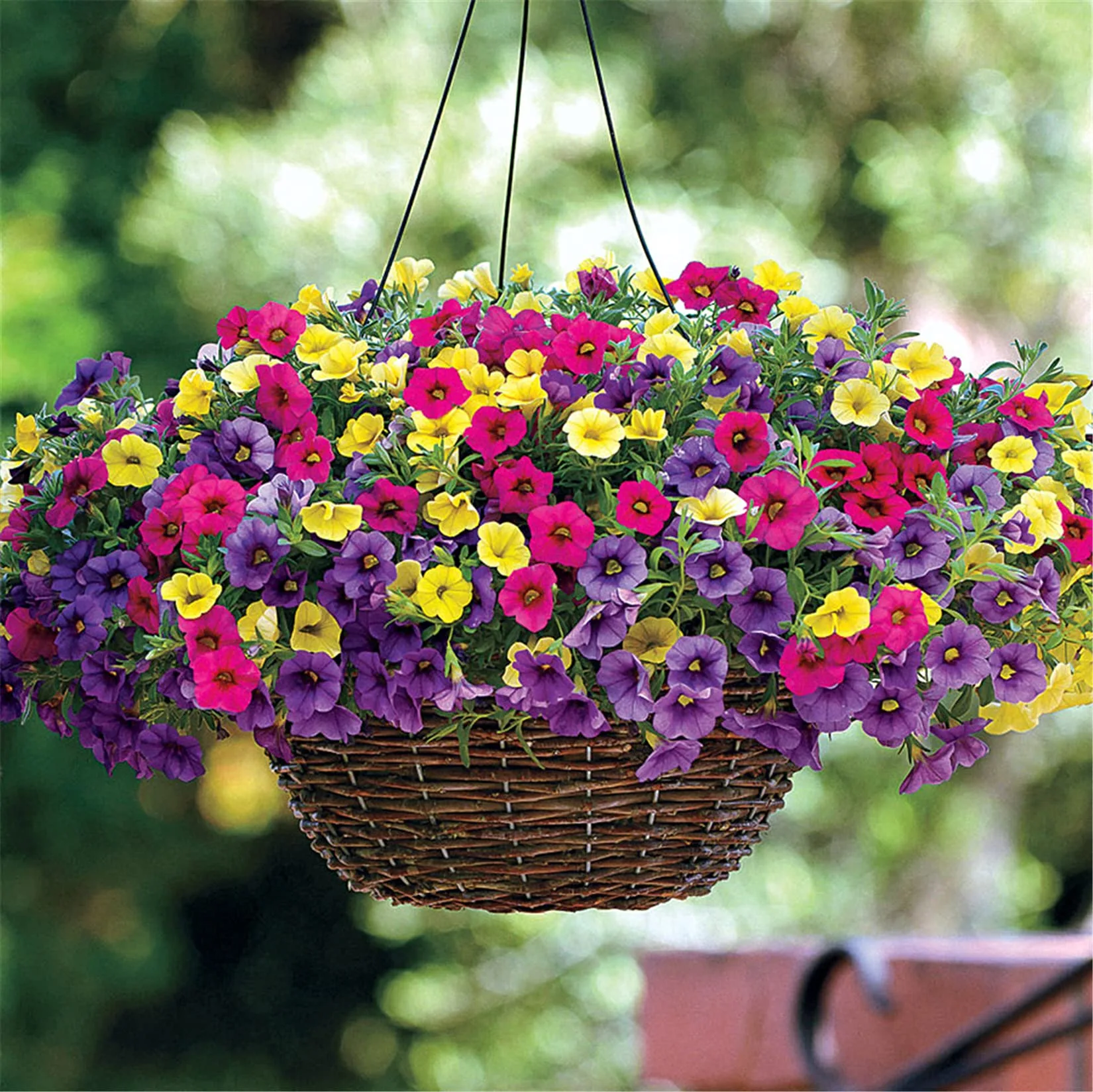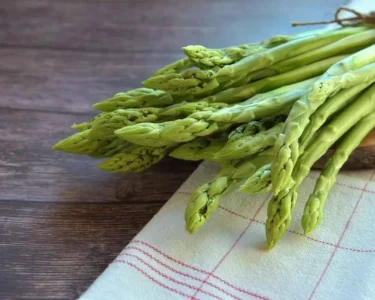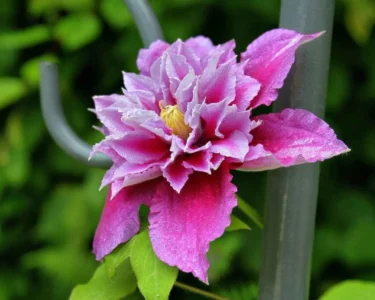Calibrachoa (often called “million bells”) is a wildly well-known flowering plant in America. It is distinguished by its tiny petunia-like flowers and its trailing habit. Calibrachoa is a great addition to hanging baskets, containers, or even garden beds.
How to Grow Calibrachoa Seeds
Before sowing seeds for calibrachoa in the US, keep these suggestions in your head:
Time and Climate: Calibrachoa is a great plant for warm weather, therefore to maximize its potential, it’s recommended to begin the seeds indoors around 6–8 weeks before the last date of fall in your area. This gives seeds a chance to germinate before the spring season arrives.
Sowing Seeds: Plant straight onto a seed-starting mix that is well-drained. Make sure not to cover the seeds completely, as seeds require light in order to develop.
Germination: For optimal germination, maintain temperatures between 70-75degF (21-24degC). Seeds will begin sprouting within two to three weeks.
Transplanting: When your seedlings have different sets of real leaves, the transplanting process can be done. Seedlings can be transplanted into larger pots or straight into your garden, dependent on your preference.
Soil and Watering: Calibrachoa favors well-drained soil that has pH levels between moderately acidic (5.5) and neutral (7.0.0). Maintain the soil’s moisture but do not let it become waterlogged.
Sunlight: Calibrachoa is at its desirable when it is exposed to complete sunshine (5-6 days per week). If you are growing them indoors, warrant that they have plenty of light, like placing them on window etc.
Fertilization: Your plants should be provided regularly with well-balanced, water-soluble fertilizers in order to ensure constant bloom.
Care and Maintenance: Plants of Calibrachoa benefit by regular deadheading, which helps to encourage new blooms. Trimming away the growth that is leggy is vital for maintaining a neat and appealing plant.
Tip
Calibrachoa should be cultivated from cuttings instead of seeds due to it being hybrid plants wich may not always yield true-to-type payoff using seeds.
Harvesting Seeds
Calibrachoa is generally regarded as to be a hybrid plant, which means taking seeds from plants might not result in plants that look like their parent. In addition, some seeds could even be sterile, which means they will not germinate when placed in soil. If you want to collect seeds of calibrachoa take these steps:
Leave flowers to mature: Allow flowers to remain on the plant until they begin to wither and die. This will allow seeds to grow and mature.
Find Seed Pods: When the flowers have faded, there are small seed pods that are green. They need enough sunlight to mature, sufficient enough to turn brown or tan just before harvest.
Collect Seed Pods: When the seed pods are dry and have reached their maturity, be sure to gently pull them off and save them for later use.
Extract Seeds
For the extraction of tiny seeds, carefully break seeds pods.
Pure Seeds: Remove any plant matter or debris from the seeds prior to placing them back in their containers.
Storage of Seeds Properly: Store seeds in the cool, dry place with envelopes of paper or small containers sealed with labels printed with your plant’s details and date stamped on them.
Before planting seeds: Since germination rates can differ between seeds, it’s advisable to test some of the seeds to assure the viability prior to planting them.
Planting: Once it’s time sow the seeds, adhere to the instructions for sowing and maintenance given in the earlier answer.
Tip
Be aware that calibrachoa that is cultivated from collected seeds might not have the characteristics of its parent plant due to hybridization. Therefore, if you are looking for specific traits for your plants, it could be better to buy new plant cuttings from a trusted source.
Here’s a brief overview of this amazing flower’s anatomy, structure, and particulars:
Growth Habitat and Structure:
Calibrachoa exhibits in a growing habit that is a cascade or undulating which makes it ideal for hanging containers and baskets and ground cover. Its stems are long and flexible – usually growing up to 12–24 inches (30-60 cm).
The flowers from Calibrachoa : Calibrachoa flowers look like petunias and are approximately 1 inch (2.5 centimeters). They come in a variety of colors, including pink and purple to yellow as well as red, orange blue, white and with some varieties having bicolor or patterned flowers.
Leaves from Calibrachoa: Calibrachoa’s leaves are tiny, narrow and a little fuzzy. They are generally lanceolate-shaped, and grow densely along the stems. Their green hue is usually accentuated by the appearance of a sticky surface.
Pods: Calibrachoa produces tiny dry seeds inside the pods after its flowers have died. They are generally brownish and round. Since calibrachoa are often hybrid plants, the seeds that are collected from it may not result same as what they were originally.
Dimension: The size and conditions of growth can impact the shape and size of a calibrachoa tree. In general, they create dense mats of foliage with flowers that can reach 6-12 inches (15-30 cm).
Calibrachoa’s fibrous root system extends all over the soil, offering stability and nutrients to the plants.
Calibrachoa plants are adored gardening staples because of their abundance of blooms as well as their low maintenance requirements. And the ability to adapt to a variety of conditions of growth – makes them an ideal choice for gardeners seeking vibrant yet versatile bloom options.
Where Can I Buy Calibrachoa Plants or seeds?
There are a variety of sources to purchase Calibrachoa seeds or plants:
Local garden centers and nurseries: Numerous garden centers and nurseries sell calibrachoa plants in the spring and summer months that come in a variety of shades. They also have trained staff that can offer advice as to how to plant and care for them.
Online retailers: There are various online retailers that sell plants and seeds of calibrachoa like Amazon, Home Depot, Lowe’s and many other number of gardening-specific stores which deliver an array of choices.
Specific Nurseries: Nurseries which specialize in hanging baskets, bedding plants or container gardens typically have calibrachoa.
Farmers Markets: Local farmers markets could have vendors selling calibrachoa plant varieties in the spring and summer season.
FAQs
What can I do to keep track of calibrachoa?
Calibrachoa needs well-drained soil regular, yet not overwatered irrigation (but not excessively watering it) and a regular feed with a balanced, water-soluble fertilizer. Full-sun (6-8 hours daily) is recommended, and regular pruning can benefit to warrant its growth.
Does calibrachoa need all-day sun?
Yes, calibrachoa thrives perfect when it is in full sunlight to bloom in abundance. Although shade in partial shade could work well for the cultivation of the perennial flowering shrub. However, too little sun could result in a lower flowering rate.
How often is it the suggested time to replenish the calibrachoa in my home?
It is suggested to keep the calibrachoa hydrated regularly to ensure that the soil is kept at a consistent water level. Avoid overwatering because it could cause root rot. It is important to remember that the frequency at which you need water is dependent on the climate in which you live and the dimensions of the container.
How do I make sure that calibrachoa has been propagated?
Calibrachoa is able to be propagated via cuttings. Utilize healthy cuttings of healthy plants. Cut off the lower leaves, put the cut ends into roots-building hormone (if you’d like) and then plant it in a pot with a draining hole. Keep a moist and warm environment that promotes the growth of roots.
Does calibrachoa require deadheading?
Calibrachoa doesn’t require deadheading since its flowers tend to clean by themselves. However doing things like getting rid of blooms that have been used up can benefit keep blooms going and preserve a pleasing appearance.
Can Calibrachoa plant grow using seeds?
Calibrachoa can be cultivated from seeds, however some varieties are hybrids and could not give true the original payoff. Seeds can be taken from mature plants, but propagation via cuttings is usually preferred to warrant consistency in outcome.
How do I fertilize my calibrachoa?
Fertilize the plants of calibrachoa frequently during their growing season by together an ad hoc water-soluble fertilizer that will ensure the blooming of the plants continues. Each 2-to-4 weeks throughout this time frame is recommended.
Do Calibrachoa plant species resistant to deer?
Although calibrachoa is typically believed to be deer-resistant, it may also be dependent on the local deer population as well as their preference.
Conclusion
Calibrachoa is a beautiful and adaptable plant with beautiful flowers in a range of shades. It’s easy to take care of in hanging baskets, containers or in garden beds that are ground-cover. Calibrachoa displays vibrant blooms throughout the growing season when provided with sufficient sunlight, watering and fertilization. You’ll be able to enjoy its appeal in your garden, with each flower it blooms! Look for seeds or plants in local gardens, online retailers or specialty nurseries. Let this gorgeous plant make a splash in your garden now.





